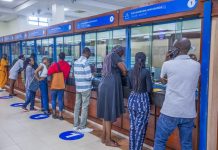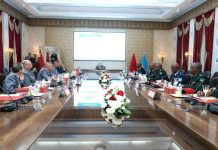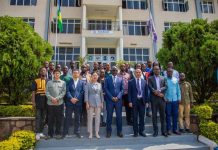Africa-Press – Rwanda. On Tuesday, November 11, President Paul Kagame participated in the launch of the Simandou Iron Ore Project in Guinea, the largest iron ore mining venture in the world.
Simandou is recognised as a mega untapped iron ore reserve, estimated to hold between three and four billion tonnes of high-grade recoverable iron ore.
The project aims to reach full production capacity by 2030, with an anticipated annual output of around 120 million tonnes.
Africa boasts several big mining projects, and in this article, The New Times briefly profiles some of them and lists them in no particular order.
Simandou Iron Ore Project (Guinea)
The Simandou iron ore project, Africa’s largest greenfield integrated mine and infrastructure project, started operation on Tuesday, with an inauguration ceremony being held at the port of Matakong, where Kagame joined Guinea’s President Mamady Doumbouya and Brice Oligui Nguema of Gabon.
With a total investment exceeding $20 billion, the mine boasts systems for mining, railways, ports, and so on. The infrastructure is expected to support a combined total of up to 120 million tons of iron ore exports per year.
Kansanshi copper project (Zambia)
Located in Zambia’s north-west, the Kansanshi mine currently undergoing expansion, is expected to have an increased output of around 53 million tonnes of copper annually.
Investment in the Kansanshi expansion accelerated in 2024 with an investment of more than $800 million, bringing total expenditure to $1.1bn. The remaining $900m investment is expected to follow by 2029.
Tasiast gold mine (Mauritania)
Mauritania’s Tasiast gold mine hit an annual production milestone of 600,000 ounces in 2023. It is operated by Kinross Mining, a Canadian-based company that extracts and processes gold and silver from mines across the world.
Jwaneng diamond mine (Botswana)
Located 160 kilometres west of Gaborone, the capital of Botswana, the Jwaneng mine is one of the richest diamond mines in the world. In 2023, it produced 13.3 million carats of diamonds. Botswana is known for its diamond production. In 2024, the country reported the discovery of the world’s second-biggest diamond (2,492 carats) from the Karowe Mine.
Goulamina lithium project (Mali)
Mali’s Goulamina mine, commissioned in December 2024, is designed to produce 500,000 tonnes of lithium spodumene per year.
It is the country’s flagship lithium initiative, with reserves of 142.3 million tonnes grading 1.38 per cent lithium oxide.
Ewoyaa lithium project (Ghana)
With an annual output forecast of 365,000 tonnes of spodumene concentrate, the upcoming Ewoyaa lithium project in Ghana is expected to diversify the country’s large mining industry.
At full capacity, Ewoyaa will also rank as one of the largest hard rock spodumene concentrate mines globally. The project comprises eight main deposits. It is located immediately north of the town of Saltpond, approximately 100 km south-west of Accra, Ghana’s capital.
Luele Diamond Mine (Angola)
The Luele mine, located in Angola’s Luaxe kimberlite deposit, is not only the largest diamond mine in Angola but also ranks among the largest in the world.
Officially inaugurated in November 2023, the mine boasts an estimated 628 million carats of diamonds and a lifespan of 60 years.
Bled El Hadba Phosphate Mine (Algeria)
The Bled El Hadba phosphate mine, located in Algeria’s Tébessa Province, boasts an estimated 1.2 billion tonnes of phosphate ore, including 800 million tonnes that are extractable.
By 2027, the project aims to produce over 5 million tonnes of phosphate annually and enable the production of phosphate-based fertilisers.
Kuvimba Lithium Project (Zimbabwe)
Kuvimba Mining House will start construction of a lithium concentration plant at its Sandawana mine in Zimbabwe, with operations expected to begin in early 2027.
The 600,000-tonne annual capacity facility represents a $270m investment.
Nyakabingo tungsten mine (Rwanda)
Nyakabingo mine in Rulindo, in Rwanda’s Northern Province produces 120 tonnes of wolframite per month, making it the leading tungsten producer in Africa.
It is operated by Trinity Metals, a mining company primarily focusing on extracting tin, tungsten, and tantalum (3Ts). The company also operates Trinity Musha Mines, and Rutongo Mines.
Trinity Metals says that the Nyakabingo mine has vast potential, estimating that it has at least 40 more years of viable mining. Rwandan tungsten enjoys a strong reputation due to its high grade.
For More News And Analysis About Rwanda Follow Africa-Press






